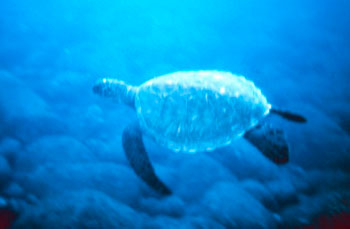Sea Turtle Cold Stun Season Has Begun in Northeast

Leatherback sea turtle. One of several species that may strand on our shores when water temperatures drop. Photo NOAA
Sea turtles are commonly found in waters off the Mid-Atlantic and Northeast United States during the summer and early fall. Typically, they begin to migrate south to warmer water by late October. Sea turtles migrate because they are cold-blooded and depend on external sources of heat to help maintain their body temperature.
However, some sea turtles strand along our shores when water temperatures drop rapidly or unexpectedly. This is called “cold stunning.” Cold stunning is similar to hypothermia in humans. Initial symptoms include a decreased heart rate, decreased circulation, and lethargy, followed by shock, pneumonia and possibly death.
While this fall started off warm, temperatures are starting to drop, and this temperature drop is having an impact on sea turtles. As of November 11, six Kemp’s ridley sea turtles have stranded due to cold stunning. Two turtles stranded in New York, and the other four stranded in Massachusetts. Five of the six turtles stranded alive and are being cared for by stranding network partners, The Riverhead Foundation for Marine Research and Preservation in New York and the New England Aquarium in Massachusetts.
“The stranding network is made up of agencies and organizations that partner with NOAA Fisheries to help sea turtles in distress,” said Kate Sampson, NOAA Fisheries Sea Turtle Stranding Coordinator. “Their work is critical to save individual animals and help us collect valuable information that we use to manage these threatened populations.”
We expect to see between 50 and 200 sea turtles cold stun in Massachusetts from late October through December. New York, specifically Long Island beaches, also see cold stunned turtles each winter, but in lower numbers.
Last year, over 450 cold-stunned sea turtles, including Kemp’s ridleys, loggerheads and greens, stranded on shore from Massachusetts to Virginia.
Northeast Region Sea Turtle Stranding Network partners involved with cold-stunned sea turtle response and rehabilitation include: University of New England Marine Animal Rehabilitation Center in Biddeford, ME, New England Aquarium in Boston/Quincy, MA, MA Audubon’s Wellfleet Bay Wildlife Sanctuary in Wellfleet, MA, National Marine Life Center in Buzzards Bay, MA, Woods Hole Science Aquarium in Woods Hole, MA, Mystic Aquarium in Mystic, CT, Riverhead Foundation for Marine Research and Preservation in Riverhead, NY, Marine Mammal Stranding Center in Brigantine, NJ, National Aquarium in Baltimore, MD, Virginia Aquarium and Marine Science Center in Virginia Beach, VA, In years when the number of turtles that cold-stun is high, other network partners jump in to help, taking animals into rehabilitation beyond the Northeast Region.
The network needs your help by reporting sea turtles you see on our beaches. To report a stranded sea turtle, please contact one of network partners. http://www.nero.noaa.gov/prot_res/stranding/reportstranding.html.
